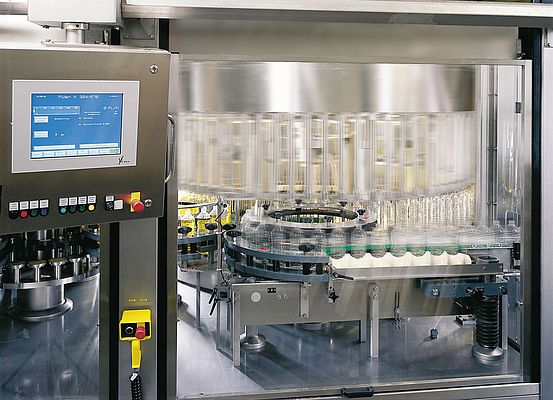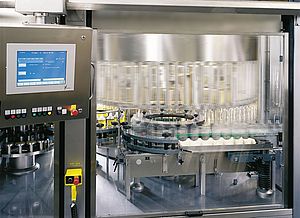With consumers increasingly demanding food that is as fresh as possible while being free from preservatives, hygiene requirements are becoming ever more stringent. This is only possible if the design of all the production systems is geared towards hygiene.
The trend now is for consumers to buy food that if possible, is fresh, untreated and without preservatives or other additives. To be able to implement this in production, you must try to make it virtually impossible for micro-organisms to get in during the production process. This means that hygiene is even more crucial in food production plants than it was in the past.
To address this, food processors are developing new techniques and technologies, some of which are unique and original while others are 'borrowed' from the pharmaceutical, medical and other super-hygienic industries.
The European Hygienic Engineering & Design Group (EHEDG) – a consortium of manufacturers, food producers and research institutes – works on specific guidelines that guarantee the best possible hygiene during food production. An important aspect to be considered here is that all the systems and components used must be easy to clean.
The EHEDG's main task is the promotion of hygienic engineering and design in all areas of food production. This includes a focus on the geometry and the surfaces that are used on components, and another on ensuring cleaning processes - both manual and automated - are truly effective right down to the microbial level.
The organisation also develops appropriate guidelines, provides certification and supports European legislation relating to food handling, processing and packaging; hygienic machinery, and operating environments (EC Directive 2006/42/EC for machinery, EN 1672-2 and EN ISO 14159 for hygiene requirements).
It has developed suitable test methods to do this. Systems and/or components are deliberately polluted with bacteria, dried and then cleaned. In a further step, a culture medium with a pH indicator, in which bacteria can reproduce, tests whether any bacteria remain after cleaning. If the colour changes, this is an indication that bacteria are still present despite the cleaning.
Typical components that are EHEDG-certified include fittings, pumps and sensors. Plant engineers deploying components with such certification are able to meet the hygiene requirements of the EU Machinery Directive.
Naturally this sort of process generates large amounts of data, as does production when the machinery is actually in use. It is essential that this data is collected efficiently and processed appropriately. Most modern production machinery includes a sophisticated electronic control system, which communicates with a plant wide network that synchronises all the different activates involved in production and plant maintenance.
Discernible in the food industry, as in many other sectors of industry, is the increasing trend towards system automation. The cleaning procedures for this type of system are often automated as well, and must therefore work without the need to dismantle system parts and components. At the same time, automated systems of this type also make increased use of sensor technology. The sensors used must therefore also meet hygiene requirements.
As an example, HBM has developed the PW27 platform load cell to comply with EHEDG guidelines and therefore be suitable for this type of food sector application. To meet the high cleanability requirements, it is hermetically encapsulated and is stainless steel throughout. This guarantees that it is compatible with all the cleaning and disinfection agents currently used by the food industry.
The design of the PW27 also makes it particularly easy to clean. For example, the top surfaces are all inclined to prevent the collection of dirt, product residue or water droplets, while laser etching replaces the usual specification stickers. With daily cleaning likely to include disinfection agents and/or high-pressure steam cleaning, the PW27 is ingress protected to IP68 – with IP69K as an option.
Naturally the PW27 has data communications capabilities so that it can send information off to higher level controllers. One of HBM's favoured communications protocols is the 'open' CC-Link protocol, which allows sensors, controllers, and other products from over 250 different manufacturers to be mixed and matched on the same network.
CC-Link is an open network technology, allowing any company to make compatible products. This gives end users tremendous freedom in choosing what equipment to install in their plants, and makes the practice of restricting compatibility employed by some automation suppliers history.
For component manufacturers like HBM this means their products are suitable for use in a vast number of installations around the world. CC-Link originated in Japan and has since come to dominate Asian manufacturing and production sectors and one of the leading technologies worldwide.
Global companies are increasingly adopting Open communications because it aids the development of worldwide purchasing strategies, whilst reducing stockholding needs and procurement costs. Further technical benefits accrue when all of their production equipment, wherever it is located, conforms to the same control and communication specification.
Customers are constantly requesting variants and new developments on their base products – new sizes, new packaging, a change of ingredients or processing techniques. Additionally, new products are frequently developed, tested, piloted and launched. All of these changes lead to constant reconfiguration of production machinery, which in turn leads to rewiring of the control system. CC-Link responds to these challenges with flexible network topologies, plus software features that makes it easy to add new stations to the network as required.
The role of hygienic design in the food and pharmaceutical industries is becoming increasingly important. Thanks to their new load cells with EHEDG certification, the sensor and measurement technology specialist HBM can enjoy a position as a supplier for food and pharmaceutical sector applications. Plant engineers who integrate the load cells into their applications can rely on a guaranteed hygienic design.
Similarly CC-Link has proved to be highly suitable for communications in hygienic applications, where its simplicity enables plant engineers to install new systems or adapt existing ones freely and effectively without excessive downtime.
Authors: Gilbert Schwartmann, HBM & John Browett, CLPA
Sensors and communication
in hygienic applications
- by Hottinger Brüel & Kjaer GmbH
- April 11, 2013
- 414 views


















